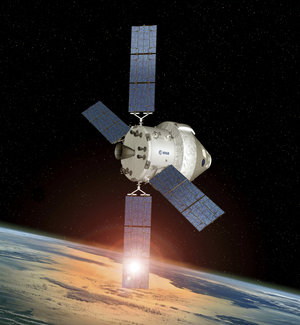Sustainable exploration
Exploring new worlds requires taking or finding the resources to keep humans alive in inhospitable places or, even better, recycling available resources indefinitely.
Today’s technology could easily get us back to the Moon, but it is still expensive to develop the vehicles and take everything needed to support life with us.
ESA wants our exploration to be sustainable and based on partnerships – not only with international space agencies but also with business. A commercial approach may just be the ticket – literally and figuratively – to making it happen.
Rather than develop complete missions from scratch – a long and costly process – ESA wants to buy rides on commercial landers to deliver our precious research equipment safely. Once there, we are ready to pay the ‘roaming charges’ to talk to our hardware.
To be truly sustainable, we must make use of resources on other planets and planetary bodies.

In addition to transportation and communication, ESA is looking to invest in the development and pay for the use of technology that can turn raw materials into oxygen and water, critical resources for sustaining future human operations in deep space.
Why the emphasis on sustainability? If been there, done that were the sole definition of exploration, then setting our sights only on more remote parts of our Solar System would make sense. While we learned a lot about the Moon from Apollo, we just scratched the surface of the vast expanse of our Universe.
By testing the market for transport services to the Moon, ESA aims to push the limits of technology and create new models of space business.
Ecosystems
By default, space missions must be as sustainable as possible because supplies are limited on spacecraft. A Moon base that does not rely on regular supply missions is more viable and could last indefinitely if it created its own fuel from local resources and solar energy.
ESA has been working for over 25 years to create a portable ecosystem so that astronauts can bring a self-contained atmosphere-in-a-box that will supply oxygen, water and food while processing their waste.

By finely tuning how microbiological cells, chemicals, catalysts, algae, bacteria and plants interact we could process waste to deliver never-ending fresh supplies of oxygen, water and food.
A test centre in Barcelona, Spain, is keeping rats alive and comfortable in a closed ecosystem, a first step towards a system that could support humans in space.
The knowledge gained along the way has direct benefits for creating a more sustainable life on Earth: knowledge on growing algae and bacteria is being directly applied to create food for villages in Congo and in research centres to improve the cultivation of biofuels based on algae.















 Germany
Germany
 Austria
Austria
 Belgium
Belgium
 Denmark
Denmark
 Spain
Spain
 Estonia
Estonia
 Finland
Finland
 France
France
 Greece
Greece
 Hungary
Hungary
 Ireland
Ireland
 Italy
Italy
 Luxembourg
Luxembourg
 Norway
Norway
 The Netherlands
The Netherlands
 Poland
Poland
 Portugal
Portugal
 Czechia
Czechia
 Romania
Romania
 United Kingdom
United Kingdom
 Slovenia
Slovenia
 Sweden
Sweden
 Switzerland
Switzerland































